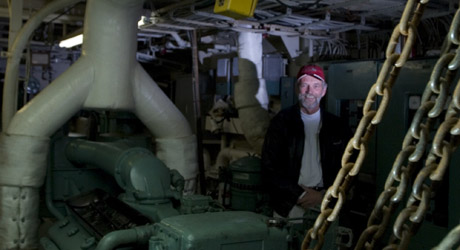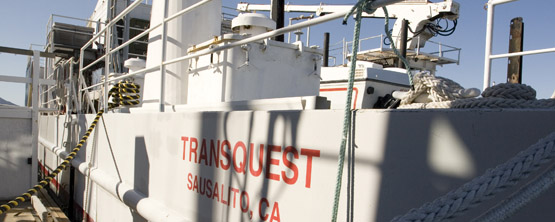while living, Working on a Spy-Boat

Case Blazyk below deck of his 108-foot vessel. Photo by Scott Hargis
By Scott Hargisase
Published: May, 2007
Blazyk is standing on the bridge of the Transquest, an ex-CIA spy vessel he purchased in 1997, dressed in white chinos, white top-siders, white long-sleeved shirt and a red Transquest ball cap. He gazes out across the Sausalito harbor. This ship has a lot of history, he says, and itís still one hundred percent operational.
Transquest is no ordinary ship. Built in 1967 by Lockheed from plans provided by the CIA, it performed clandestine missions around the world for nearly thirty years before being decommissioned in the summer of 1997. Its missions involved deploying and recovering deep-sea submersibles, which the Navy was ostensibly developing as rescue vessels for its growing nuclear sub fleet, but, in actuality were often used as spy vessels, undertaking sea floor wiretapping missions and salvaging lost Soviet submarines and missiles.
At 108 feet long, and 39 feet wide, Transquest is not built for speed, especially considering its square bow and the 50-ton elevator used to launch and retrieve subs. Its unique design and equipment make it an extremely versatile research vessel. Blazyk has been hired by National Oceanic & Atmospheric Association, and other government agencies, to perform various missions off the California coast. But there arenít enough launch-and-recovery jobs available to keep the ship a going concern, and Blazyk, 56, worries that heíll have to leave Sausalito, where heís lived for 17 years. Maybe itís time to head for warmer waters, says the Michigan native, who also owns a home and property in Colorado.
Blazyk was buying and selling military surplus in 1997 when he was approached by Lockheed Martin, which had owned and operated Transquest throughout its history. The ship was no longer needed and they were looking for a buyer. Would Blazyk be interested?
Blazyk traveled to San Diego and had the vessel inspected from top to bottom. Everything was in perfect condition, he said. The U.S. government had paid for a major overhaul only a few years before. Before the deal closed, a government team went aboard and carried off many cartons of papers and classified equipment. But the operational components of the ship were left intact; including two generators that Blazyk says could provide enough power to supply the entire city of Sausalito if necessary.
Blazyk lives aboard the Transquest and performs maintenance and upgrades on the vessel himself. In the hydraulic/generator room, he proudly shows the innards of an enormous diesel generator, which he is repairing following a water leak. These are in fantastic condition, he said. After running through a litany of equipment the boat has, including the Gyroscopic autopilot, 50 gallon per hour water desalinator, 7.5-ton deck crane, and the newly installed 64-mile radar, he said, I must not have had enough toys as a child.
After forty years of mostly secretive duty, Transquest is ready for the next chapter to begin. Itís unclear what that chapter will bring, but Blazyk is ready.

Case Blazyk on a boat built for speed, in front of his live/work boat, built with other missions in mind. Photo by Loren Earle Cruickshanks

The Transquest, once a U.S. government spy ship, still runs at 100 percent and is research ready. Photo by Scott Hargis

